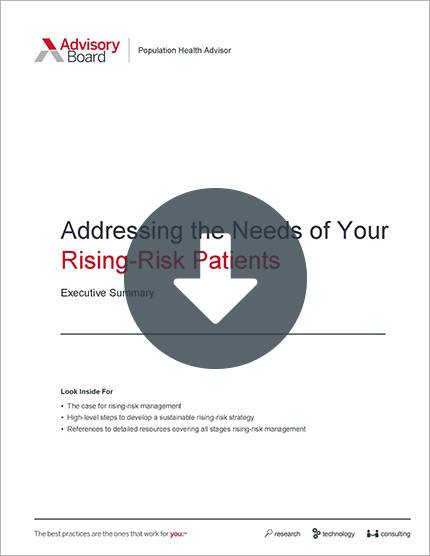Every provider engaged in risk-based contracts agrees that effective care management for high-risk patients is a universal starting point. However, for progressive organizations surfacing the needs of rising-risk patients for targeted improvement is the logical next step—but that's easier said than done.
Each year, about 18% of rising-risk patients escalate into the high-risk category when not managed. By investing in rising-risk patient management, organizations can significantly slow the churn of rising-risk patients into the high-risk patient cohort and avoid associated future costs.
This research briefing covers the case for rising-risk management and includes four high-level steps to develop a sustainable strategy.
Developing a sustainable rising-risk strategy
Leading organizations ensure that strategic resources are largely allocated at the intersection of primary care and chronic disease management to curb cost and demand. To do so, they target rising-risk management efforts based on key patient risk factors across four high-level steps.
1. Refresh your strategy to identify at-risk patients every one to two years
- Related resource: How to Prioritize Population Health Interventions
2. Use the medical home as the epicenter of patient management
- Related resource: Five Steps to Build the Advanced Medical Home
3. Engage community organizations to fill care gaps surfaced in the community health needs assessment
- Related resource: Building the Business Case for Community Partnership
Don't miss out on the latest Advisory Board insights
Create your free account to access 1 resource, including the latest research and webinars.
Want access without creating an account?
You have 1 free members-only resource remaining this month.
1 free members-only resources remaining
1 free members-only resources remaining
You've reached your limit of free insights
Become a member to access all of Advisory Board's resources, events, and experts
Never miss out on the latest innovative health care content tailored to you.
Benefits include:
You've reached your limit of free insights
Become a member to access all of Advisory Board's resources, events, and experts
Never miss out on the latest innovative health care content tailored to you.
Benefits include:
This content is available through your Curated Research partnership with Advisory Board. Click on ‘view this resource’ to read the full piece
Email ask@advisory.com to learn more
Click on ‘Become a Member’ to learn about the benefits of a Full-Access partnership with Advisory Board
Never miss out on the latest innovative health care content tailored to you.
Benefits Include:
This is for members only. Learn more.
Click on ‘Become a Member’ to learn about the benefits of a Full-Access partnership with Advisory Board
Never miss out on the latest innovative health care content tailored to you.

